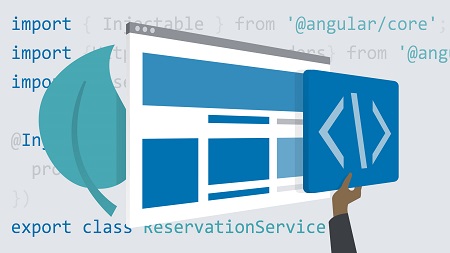
English | MP4 | AVC 1280×720 | AAC 48KHz 2ch | 2h 15m | 488 MB
Angular is known for building rich, data-driven single page applications (SPAs), while Spring Boot is a popular and powerful framework for back-end development. In this course, Chris Anatalio shows how to take these two enterprise-scale worthy technologies and build a robust, secure full-stack application. Learn how to build an app that uses this reactive Spring stack to create a REST API on the back end, and an Angular front end that leverages that data. After highlighting the benefits of using reactive programming with Angular and Spring, Chris covers using, configuring, and implementing reactive Spring Data; building a reactive Spring Data client-side functionality with Angular; testing; and more.
Topics include:
- Benefits of using reactive programming with Angular and Spring
- Bootstrapping your Spring Boot app
- Building a reactive Spring REST API
- Creating and testing a WebFlux GET endpoint
- Building a front-end app with Angular
- Using and configuring reactive Spring Data
- Using a REST API GET request
- Unit testing with Spring Boot and Angular
Table of Contents
1 Zero to full-stack app with Angular and Spring Boot
2 What you should know before watching this course
3 Set up your dev environment
4 Benefits of using reactive programming with Angular
5 Benefits of using reactive programming with Spring
6 Integrate Angular and Spring
7 High-level Angular and Spring reactive flows
8 Spring Initializr
9 Import the project into IntelliJ
10 How you are using Spring WebFlux
11 Create your controller configuration
12 Create a basic POJO model
13 Build a GET endpoint with Spring WebFlux
14 Test your GET endpoint
15 Create new data with a POST endpoint
16 Update your data with a PUT endpoint
17 Build a DELETE endpoint with Spring WebFlux
18 How you are using Angular
19 Bootstrap an Angular app with the CLI
20 Import dependencies
21 Import static HTML and CSS
22 Create an Angular directive
23 Using Spring data and MongoDB
24 Spring data config
25 Create the service interface
26 Update data in MongoDB
27 Delete data in MongoDB
28 Autowire read and create functionality into the controller
29 Autowire update and delete functionality into the controller
30 Send REST calls with HttpClient
31 Create an Angular reactive form, part 1
32 Create an Angular reactive form, part 2
33 Create a service method to POST data to your REST API
34 Create a consume service method to create a reservation
35 Create a list all endpoint
36 Implement REST call to GET data using your REST API
37 Display results from a GET call
38 Unit testing with Spring Boot
39 Unit testing with Angular
40 Next steps
Resolve the captcha to access the links!